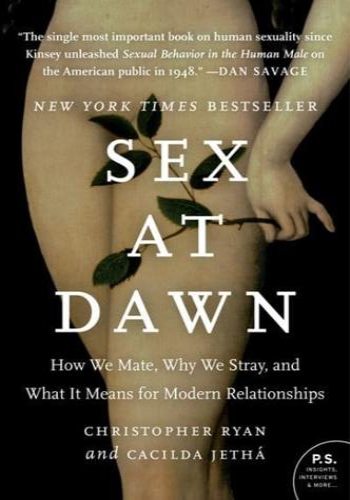Introduction
Sex at Dawn: How We Mate, Why We Stray, and What It Means for Modern Relationships is a book written by Christopher Ryan and Cacilda Jethá. The book explores the history of human sexuality and questions the traditional notions of monogamy and fidelity in relationships. Ryan and Jethá suggest that humans are not biologically inclined towards lifelong sexual monogamy and that our evolutionary history points towards a more diverse and complex mating behavior.
Chapter One: Getting Our History Straight
In the first chapter, Ryan and Jethá set the stage for their argument by examining the prevalent myths and misconceptions about human sexuality. They challenge the idea that humans have always been monogamous and that monogamy is the natural state of human relationships. They present evidence from evolutionary psychology, anthropology, and history to support the idea that humans have a long history of non-monogamous behavior.
Example: The authors cite research that found only 17% of societies around the world practice monogamy exclusively; the rest have some form of non-monogamous relationships.
Chapter Two: Tales of Human Nature
The authors delve deeper into the evolutionary history of human sexuality in this chapter. They argue that while the sexual behavior of modern humans may differ from our closest primate relatives, we still share the same evolutionary roots. The authors suggest that humans evolved in tropical environments where food and resources were plentiful, and there was less pressure to compete for scarce resources.
Example: The authors compare the mating behavior of bonobos, who engage in frequent sexual activity with multiple partners, to that of chimpanzees, who engage in more aggressive and competitive mating behaviors.
Chapter Three: Nothing Natural About Civilization
In this chapter, Ryan and Jethá explore how the transition from hunter-gatherer societies to agricultural societies changed human sexual behavior. They argue that the shift from communal living to more private and sedentary lifestyles led to the development of monogamy as a means of controlling resources and inheritance. The authors suggest that monogamy was never part of our natural evolutionary history and was instead imposed by the demands of early agricultural societies.
Example: The authors examine the sexual practices of a contemporary hunter-gatherer tribe, the Yanomamö of the Amazon, who actively encourage extramarital affairs to strengthen social bonds and reduce conflict.
Chapter Four: Chinese Whispers
In this chapter, Ryan and Jethá tackle the concept of paternity and how it has been used as a means of controlling female sexuality. They suggest that the institution of monogamy was created to ensure paternity and property rights, but that it has little to do with biology or human evolution. The authors argue that by placing so much emphasis on monogamy and fidelity, we have created a rigid and often unhealthy relationship structure.
Example: The authors discuss the concept of "cuckoldry," where men are often obsessed with paternity and go to extreme measures to ensure that their partner's offspring are biologically theirs.
Chapter Five: Of Sex and Men
This chapter explores the role of male sexual desire and how it has been socially constructed throughout history. The authors argue that men have a natural desire for multiple sexual partners and that the social norms of monogamy and fidelity are driven by societal expectations rather than biology. They also discuss the role of male competition in sexual behavior and how it has shaped our understanding of male sexuality.
Example: The authors use the example of the "coolidge effect," where male rats show a strong preference for new sexual partners, to support the idea that men have a natural inclination towards multiple sexual partners.
Chapter Six: Of Sex and Women
In contrast to the idea of male sexual desire being natural and focused on diversity, the authors suggest that female sexual desire is often overlooked and undervalued. They argue that while societal expectations and gender roles may have led to the suppression of female sexual desire, women may also have a natural inclination for multiple sexual partners. The authors challenge the traditional idea of men as the more promiscuous gender and suggest that women potentially have an equal desire for sexual variety.
Example: The authors discuss how the portrayal of female sexuality in society has often focused on male pleasure and that female pleasure and desire have been overlooked.
Chapter Seven: What Do Women Want?
This chapter dives deeper into female sexual desire and challenges the notion that women are naturally monogamous. The authors argue that women may also have a natural inclination towards multiple sexual partners and that the societal expectation of female monogamy may not align with our biology. They also discuss how cultural constructs and gender roles have played a role in shaping our understanding of female sexuality.
Example: The authors present evidence from studies on female primates, such as bonobos and chimpanzees, to support the idea that female sexual behavior may be more diverse and varied than previously thought.
Conclusion
In the final chapter, Ryan and Jethá summarize their argument and highlight the need for a more honest and open conversation about human sexuality. They call for a shift in societal attitudes towards relationships and challenge the idea that monogamy is the only "normal" or "natural" way to love and be intimate with others. The authors conclude by suggesting that by understanding our evolutionary history, we can create more fulfilling and authentic relationships.
Example: The authors highlight the need for greater acceptance and understanding of non-monogamous relationships and the importance of open communication and consent in all relationships.







